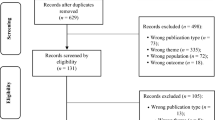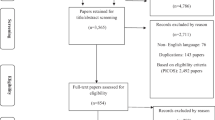Abstract
The purpose of this study was to use a meta-analytic procedure to synthesize the rates of disordered gambling for college students that have been reported in the research literature. In order to identify all possible studies that met stringent inclusion criteria, Medline, PsychINFO, and SocioIndex databases were searched with the terms “gambling,” and “college student”. This process resulted in 15 studies concerning gambling among college students that were published through July 2005. To synthesize the 15 studies, a random effects model for meta-analysis was applied. The estimated proportion of disordered gamblers among college students was 7.89%. This estimate is noteworthy because it is higher than that reported for adolescents, college students or adults in a previous study using meta-analytic procedures with studies conducted prior to 1997.
Similar content being viewed by others
References
American Psychiatric Association (1980). Diagnostic and statistical manual of mental disorders (3rd ed.) (DSM-III). Washington, DC: APA.
Arnett, J. (2000). Emerging adulthood: A theory of development from the late teens through the twenties. American Psychologist, 55, 469–480.
Arnett J. (2004). Emerging adulthood. New York: Oxford University Press.
Arnett, J. (2005). The developmental context of substance use in emerging adulthood. Journal of Drug Issues, 35, 235–254.
Babouskin, H. R., Hardoon, K. K., Derevensky, J. L., & Gupta, R. (2001). Underlying cognitions in gambling behavior among university students. Journal of Applied Social Psychology, 31, 1409–1430.
Bailey, E. A., Burroughs, S. W., Dabit, J. S., Hambrick, R. S., & Theriot, P. B. (1997). The lure of casino gambling and its potential impact on college students in Mississippi. College Student Affairs Journal, 17, 81–92.
Chassin, L., Pitts, S. C., & Prost, J. (2002). Binge drinking trajectories from adolescence to emerging adulthood in a high-risk sample: Predictors and substance abuse outcomes. Journal of Consulting and Clinical Psychology, 1, 67–78.
Chiu, J. (1997). Predictors of gambling behavior among college students. Unpublished doctoral dissertation, Texas Tech University.
Cochran, W. G. (1954). The combination of estimates from different experiments. Biometrics, 10, 101–129.
Draper D., Graver, D. P., Goel, P .K., Greenhouse, J. B., Hedges, L. V., Morris, C. N., Tucker, J. R., & Waternaux, C. M. (1992). Combining information: Statistical issues and opportunities for research. National Academy Press: Washington.
Engwall, D., Hunter, R., & Stenberg, M. (2004). Gambling and other risk behaviors on university campuses. Journal of American College Health, 52, 245–255.
Frank, M. L (1990). Underage gambling in Atlantic City casinos. Psychological Reports, 67, 907–912.
Hulsey, C. D. (2001). Predictors of problem gambling among college students. .
Knapp G., & Hartung, J. (2003). Improved tests for a random effects meta-regression with a single covariate. Statistics in Medicine, 21, 2693–2710.
LaBrie, R. A., Shaffer, H. J., LaPlante, D. A., & Wechsler, H. (2003). Correlates of college student gambling in the United States. Journal of American College Health, 52, 53–62.
Ladouceur, R., Dubé, D., & Bujold, A. (1994). Prevalence of pathological gambling and related problems among college students in the Quebec metropolitan area. Canadian Journal of Psychiatry, 39, 289–293.
Langewisch, M. W., & Frisch, G. R. (1998). Gambling behavior and pathology in relation to impulsivity, sensation seeking, and risky behavior in male college students. Journal of Gambling Studies, 14, 245–262.
Lesieur, H. R., & Blume, S. B. (1987). The South Oaks Gambling Screen (SOGS): A new instrument for the identification of pathological gamblers. American Journal of Psychiatry, 144, 1184–1188.
Lesieur, H. R., Cross, J., Frank, M., Welsch, M., White, C. M., & Rubenstein, G. et al. (1991). Gambling and pathological gambling among university students. Addictive Behaviors, 16, 517–527.
Lopez, V. V. (2001). Psychosocial variables and college student gambling. Unpublished doctoral dissertation, U. of New Mexico.
Mengersen, K. L., Tweedie, R. L., & Biggerstaff, B. J. (1995). The impact of method choice in meta-analysis. Australian Journal of Statistics, 37, 19–44.
Neighbors, C., Lostutter, T. W., Cronce, J. M., & Larimer, M. E. (2002). Exploring college student gambling motivation. Journal of Gambling Studies, 18, 361–370.
Neighbors, C., Lostutter, T. W., Larimer, M. E., & Takushi, R. Y. (2002). Measuring gambling outcomes among college students. Journal of Gambling Studies, 18, 339–358.
Orlando, M., Tucker, J. S., Ellickson, P. L., & Klein, D. J. (2004). Developmental trajectories of cigarette smoking and their correlates from early adolescence to young adulthood. Journal of Consulting and Clinical Psychology, 72, 400–410.
Oster, S. L., & Knapp, T. J. (1998). Sports betting among college students: Who bets and how often? College Student Journal, 32, 289–292.
Oster, S. L., & Knapp, T. J. (2001). Underage and pathological gambling by college students: Emerging problem on campus? Psychology & Education: An Interdisciplinary Journal, 38, 15–19.
Powell, J., Hardoon, K., Derevensky, J. L., & Gupta, R. (1999). Gambling and sensation-seeking behavior among university students. Substance Use and Misuse, 34, 1167–1184.
Rockey, D. L., Beason, K. R., Howington, E. B., Rockey, C. M., & Gilbert, J. D. (2005). Gambling by Greek-affiliated college students: An association between affiliation and gambling. Journal of College Student Development, 46, 75–87.
Rohrbach, L. A., Sussman, S., Dent, C. W., & Sun, P. (2005). Tobacco, Alcohol, and other drug use among high-risk young people: A five-year longitudinal study from adolescence to emerging adulthood. Journal of Drug Issues, 35, 333–356.
Shaffer, H., Hall, M. N., & Vander Bilt, J. (1999). Estimating the prevalence of disordered gambling behavior in the United States and Canada: A research synthesis. American Journal of Public health, 89, 1369–1376.
Sidik, K., & Jonkman, J. N. (2005a). Simple heterogeneity variance estimation for meta-analysis. Journal of the Royal Statistical Society, Series C: Applied Statistics, 54, 367–384.
Sidik, K., & Jonkman, J. N. (2005b). A note on variance estimation in random effects meta-regression. Journal of Biopharmaceutical Statistics, 15, 823–838.
Stinchfield, R. (2002). Reliability, validity, and classification accuracy of the South Oaks Gambling Screen (SOGS). Addictive Behavior, 27, 1–19.
Takushi, R Y., Neighbors, C., Larimer, M., Lostutter, T.Y., Cronce, J. M., & Marlatt, G. A. (2004). Indicated prevention of problem gambling among college students. Journal of Gambling Studies, 20, 83–93.
Tucker, J. S., Ellickson, P. L., Orlando, M., Martino, S. C., & Klein, D. J. (2005). Substance use trajectories from early adolescence to emerging adulthood: A comparison of smoking, binge drinking, and marijuana use. Journal of Drug Issues, 35, 307–332.
Winters, K. C., Bengston, P., Dorr, D., & Stinchfield, R. (1998). Prevalence and risk factors of problem gambling among college students. Psychology of Addictive Behaviors, 12, 127–135.
Author information
Authors and Affiliations
Corresponding author
Rights and permissions
About this article
Cite this article
Blinn-Pike, L., Worthy, S.L. & Jonkman, J.N. Disordered Gambling among College Students: A Meta-Analytic Synthesis. J Gambl Stud 23, 175–183 (2007). https://doi.org/10.1007/s10899-006-9036-2
Published:
Issue Date:
DOI: https://doi.org/10.1007/s10899-006-9036-2




